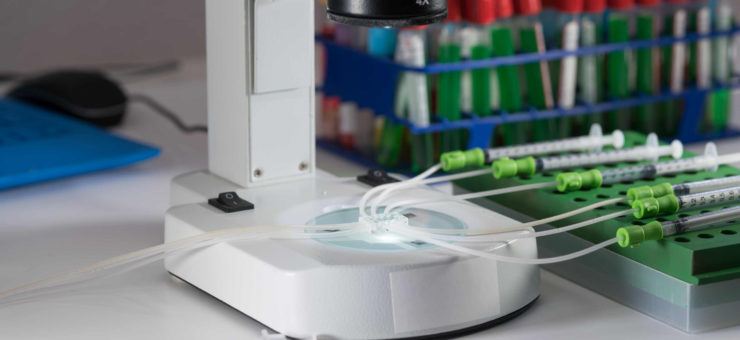Key interface challenges for lab-on-a-chip devices
5 July 2022
In the latest in Springboard’s series of posts about the common challenges with LOAC devices, we explore some of the key interfacing challenges, and some of the approaches Springboard have used to address them.
Lab-on-a-chip devices can exploit the benefits of miniaturizing fluidic systems to achieve improved accuracy, repeatability, speed, and usability when compared to traditional lab processes. However, it is necessary for these microfluidic systems to interface with the macro-world, to enable the loading and extraction of reagents and samples, and to actuate and control the processes being carried out.
Fluidic connections
For R&D purposes, simple push-fits or adhesives are typically suitable, but for a commercial product a non-permanent but durable and easy-to-use solution is required. Standardised microfluidic connectors have been discussed in the industry for many years, but none have yet emerged as a genuine viable standard [1]. We have previously developed a customised connector for a client to achieve multi-way connections in a single user step.
Electrical connections
Most of the state-of-the-art devices being developed require some form of electrical interface, either for sensing or actuation of the fluid, or both. Many of these devices rely on standard connectors from other industries. Card edge connectors provide a very simple and low-cost connection on the disposable side but can be unreliable when many plug-unplug cycles are required over the life of an instrument. ‘Pogo-pin’ style sprung connectors are common in consumer devices for this sort of temporary connection and can be suitable for LOAC devices. With an increasing number of channels required for complex technologies such as Electrowetting on Dielectric (EWOD) and space at a premium, the density of pins can become a limiting factor.
The future of wireless LOAC devices is exciting and perhaps not too far away. Keeping cost of disposables down remains a challenge, as does powering the device. Perhaps other sources of power can be used however, from on the chip itself [2] or even from the human body.
Thermal interfaces
The repeatability of results on a LOAC device may be influenced by the extent to which thermal uniformity and accurate control can be achieved. Creating a good thermal interface with the device without introducing mechanical stresses which could distort the microfluidic channels requires both carefully controlled tolerances and intelligent design of the interface. We use a combination of advanced physics simulations and rapid testing to ensure that our clients’ requirements are met.
Thermal cycling causes stresses due to differential expansion and conformable materials may need to be built in to allow for this. Autofluorescence of materials must be considered if optical analysis is to be used. Springboard’s team of materials experts can help you to choose the most appropriate materials for your device, and our experienced design engineers are used to designing devices to work reliably even when extreme precision is required.
Do you need a hand with your LOAC projects? Contact us today to find out how we can help.
Written by Adam Nightingale


